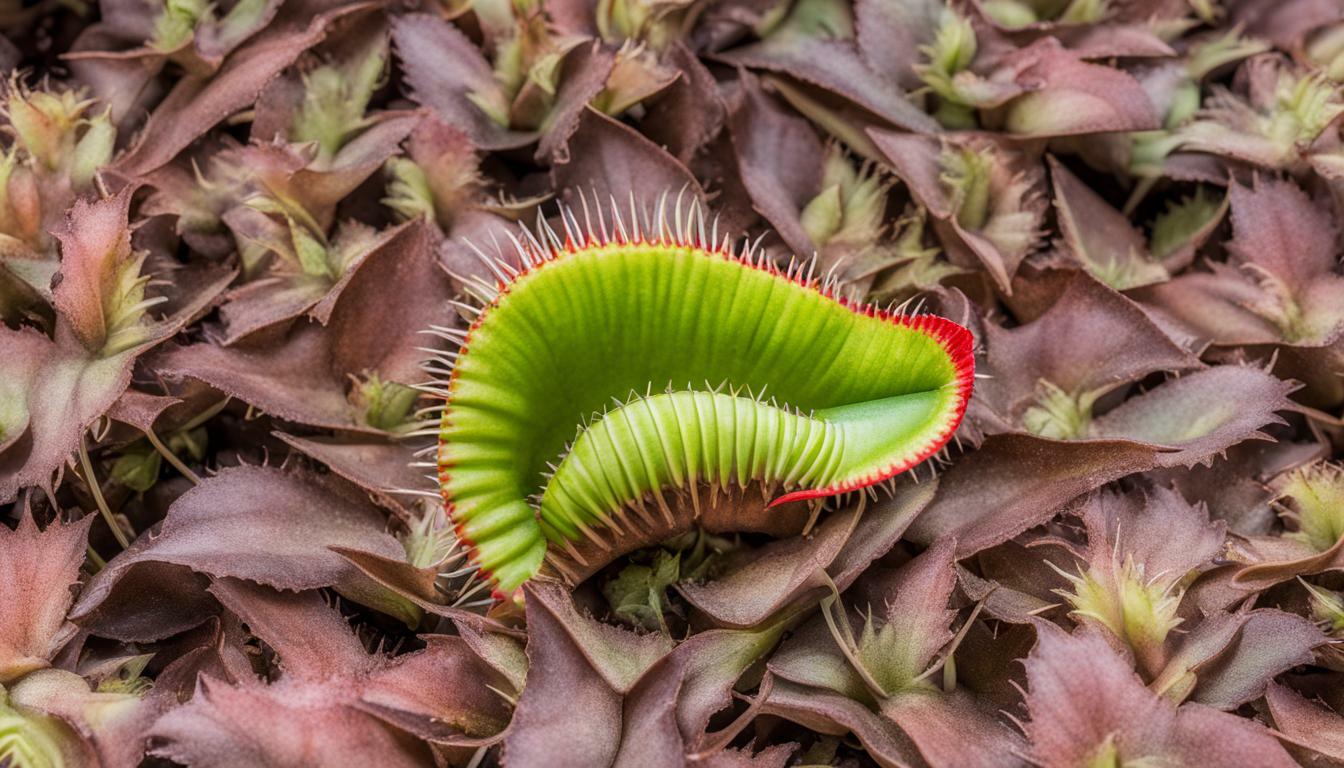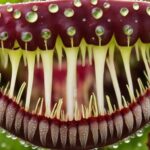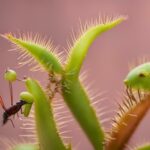If you’re a Venus flytrap owner, you may be wondering how many times your plant can close before it dies. The answer is not as simple as a specific number, as there are various factors that can impact a Venus flytrap’s lifespan and survival. Understanding the closing mechanism, lifespan, and survival strategies of Venus flytraps is the key to providing optimal care for these fascinating plants.
Key Takeaways:
- Venus flytraps have a unique mechanism for closing their leaves to capture prey
- The number of times a Venus flytrap can close before it dies depends on several factors
- Venus flytraps have adaptations that allow them to survive in nutrient-poor environments
- The feeding habits of Venus flytraps involve capturing and digesting insects for additional nutrients
- The environmental conditions can greatly impact the health and lifespan of Venus flytraps
Understanding the Venus Flytrap Closing Mechanism
The Venus Flytrap is a carnivorous plant that captures and consumes insects. Its unique mechanism for trapping prey has fascinated scientists and nature lovers alike for centuries.
The closing mechanism of a Venus Flytrap is triggered by the touch of prey on its sensitive trigger hairs. When two or more trigger hairs are stimulated within 20 seconds of each other, the plant will close its trap. This is a remarkable feat, as it requires a great amount of energy to close the trap, which the plant must conserve in between meals.
The trap of a Venus Flytrap is composed of two halves, held together by a hinge. The inner surface of each half is lined with tiny hairs called cilia, which interlock to create a seal. Once the trap is closed, the plant secretes digestive enzymes to break down its prey. This process takes several days, after which the trap will reopen, ready to capture its next meal.
The Venus Flytrap’s closing mechanism is a remarkable adaptation to its nutrient-poor environment. By capturing and consuming insects, the plant is able to obtain the necessary nutrients for growth and survival.
The Energy Requirements for Closing a Venus Flytrap
It takes a tremendous amount of energy for a Venus Flytrap to close its trap. In fact, each time the trap is closed, the plant uses around 3% of its total energy reserves. For this reason, a Venus Flytrap must be selective about when it closes its trap.
The plant conserves energy when it is not capturing prey by keeping its trap open wider than necessary. This makes it less sensitive to touch and therefore less likely to close accidentally. The Venus Flytrap can also detect the presence of non-prey items, such as raindrops or debris, and will not close its trap on them to avoid wasting energy.
The Venus Flytrap’s closing mechanism is an incredible example of nature’s efficiency and adaptation to challenging environments. Understanding this mechanism is crucial for successfully caring for and cultivating these fascinating plants.
The Lifespan of a Venus Flytrap
If you’re considering adding a Venus flytrap to your plant collection, it’s important to understand the average lifespan of this fascinating plant. The Venus flytrap is a unique species that has adapted to thrive in nutrient-poor environments, such as bogs and wetlands in the southeastern United States.
The average lifespan of a Venus flytrap is about five years, although some may live up to ten years under ideal conditions. However, the exact lifespan can vary due to a variety of factors, including environmental conditions, care and maintenance, and natural life cycle.
The Venus flytrap has a natural life cycle that includes a period of dormancy during the winter months. During this time, the plant will stop growing and may appear dead or dormant. However, with proper care and maintenance, the Venus flytrap will begin to grow again in the spring.
Proper care and maintenance are essential for the longevity of your Venus flytrap. This includes providing the right growing conditions, such as a humid environment and well-draining soil. It’s also important to avoid overfeeding your plant, as this can lead to a shorter lifespan.
In addition, avoid disturbing or damaging the traps of your Venus flytrap, as this can cause stress and impact its overall health. Some experts suggest limiting the number of times you trigger the traps to only once per week.
Lastly, it’s important to note that Venus flytraps are a protected species. While they can be purchased from reputable nurseries and online retailers, it is illegal to collect Venus flytraps from the wild.
In summary, the Venus flytrap has an average lifespan of around five years and can live up to ten years under ideal conditions. Proper care and maintenance, as well as avoiding overfeeding and damaging the traps, are essential for a long and healthy life for your Venus flytrap.
Strategies for Venus flytrap survival
Venus flytraps are fascinating plants that have adapted to survive in nutrient-poor environments. They have developed a unique ability to capture and digest insects, which provides them with additional nutrients that are lacking in their natural habitat. Here are some of the survival strategies employed by Venus flytraps:
1. Insect capture and digestion
Venus flytraps use their unique closing mechanism, triggered by the movement of insects. Once an insect is trapped, the plant secretes enzymes to digest the prey and absorb the nutrients. This adaptation provides the plant with additional nutrients that are crucial for its survival and growth.
2. Energy conservation
Venus flytraps are very energy-efficient plants. They invest a lot of energy in capturing insects, but they also conserve energy when not capturing prey. The Venus flytrap’s leaves are designed to capture sunlight, and they can produce their own energy through photosynthesis. This energy is crucial for the plant’s survival, especially during periods when prey is scarce.
3. Resistance to harsh weather conditions
Venus flytraps are adapted to withstand harsh weather conditions. They can survive through periods of drought and extreme temperatures. They are also tolerant of poor soil conditions and can grow in sandy or nutrient-poor soils. This tolerance to harsh conditions is critical for the survival of Venus flytraps in their natural habitat.
By understanding the survival strategies of Venus flytraps, you can provide them with the right care and environment for their growth and survival. Investing in the proper care and maintenance of these unique plants can provide a rewarding experience for any plant enthusiast.
Venus Flytrap Feeding Habits
While the Venus flytrap is known for its carnivorous diet, it doesn’t consume just any insect that crosses its path. The plant’s feeding habits are highly selective and only target specific types of prey.
The Venus flytrap’s preferred food is insects that are small and protein-rich, such as ants, flies, and beetles. These insects are attracted to the nectar on the plant’s leaves, which is used to lure them in.
Once an insect lands on the leaf and touches one of the plant’s trigger hairs, the Venus flytrap’s closing mechanism is triggered. The plant’s leaves will snap shut within half a second, trapping the insect inside.
The Venus flytrap then secretes digestive enzymes to break down the insect’s proteins and other nutrients. This process can take several days to complete, after which the plant reopens its leaves and discards the insect’s exoskeleton.
It’s important to note that while Venus flytraps are carnivorous, they don’t need to eat insects to survive. In fact, the plant can go weeks or even months without catching any prey and still thrive. However, a lack of nutrients from insects may cause the plant to grow more slowly or produce fewer leaves.
Environmental factors affecting Venus flytrap health
When it comes to the health of your Venus flytrap, environmental factors play a crucial role. Understanding the ideal conditions for your plant will help ensure its survival and longevity.
Light
Venus flytraps require bright, indirect sunlight to thrive. Too much direct sunlight can scorch their leaves and damage their photosynthetic ability. If you’re growing your plant indoors, place it near a south-facing window or under grow lights for at least 10-12 hours per day.
Temperature
Venus flytraps are native to subtropical wetlands and require warm temperatures to grow. The optimal temperature range for Venus flytraps is between 70-90°F during the day and 40-60°F at night. Anything outside of this range can cause stress to your plant.
Humidity
Venus flytraps thrive in high humidity environments, ideally between 50-60%. If the air becomes too dry, the plant’s ability to absorb nutrients through its leaves can be compromised. You can increase humidity levels by misting your plant’s leaves with water or placing a tray of water near its container.
Soil conditions
Venus flytraps require a nutrient-poor, acidic soil with good drainage. Avoid using regular potting soil, as it contains too many nutrients that can harm your plant. Instead, use a mixture of peat moss and perlite or sand. Make sure the soil is consistently moist but not waterlogged, as this can cause root rot.
By taking the time to provide the right environment for your Venus flytrap, you can ensure its survival and enjoy watching it thrive.
Conclusion
By now, you have gained a better understanding of the fascinating nature of Venus flytraps. You now know that they can close multiple times before they die, thanks to their amazing closing mechanism triggered by sensitive hairs. You also learned about the importance of providing the right environmental conditions to ensure their survival.
It’s important to note that Venus flytraps have a limited lifespan, but this can be extended with proper care and maintenance. Additionally, their feeding habits play a crucial role in their survival, as they rely on insects for additional nutrients.
Overall, Venus flytraps are remarkable plants with unique adaptations that allow them to thrive in nutrient-poor environments. By understanding their closing mechanism, lifespan, survival strategies, and feeding habits, you can successfully care for and cultivate these fascinating plants.
What Type of Food Should I Feed My Venus Flytrap Indoors to Keep it Alive?
When it comes to feeding a venus flytrap indoors, the right type of food is crucial for its survival. These carnivorous plants rely on insects for necessary nutrients, making small flies and other small insects ideal choices. It’s important to remember that overfeeding or using the wrong type of food can harm your Venus Flytrap. So, sticking to its natural diet is essential for its well-being.
FAQ
Q: How many times can a Venus flytrap close before it dies?
A: The number of times a Venus flytrap can close before it dies varies depending on various factors such as its overall health, environmental conditions, and availability of prey. However, on average, a Venus flytrap can close and reopen its trap about 4-6 times before it dies. It’s important to note that each closing and reopening consumes energy, so over time, the plant’s ability to close decreases.
Q: How does the Venus flytrap closing mechanism work?
A: The Venus flytrap closing mechanism is a fascinating process. The plant has trigger hairs on the inner surfaces of its trap. When an insect or object touches these trigger hairs, it stimulates an electrical signal that activates the closing process. The trap closes rapidly, capturing the prey inside. The trapping mechanism is powered by hydraulic pressure within the plant’s cells, which allows the trap to snap shut quickly.
Q: What is the average lifespan of a Venus flytrap?
A: The average lifespan of a Venus flytrap is around 20 years if provided with proper care and maintenance. However, in their natural habitat, Venus flytraps can live for up to 30 years or more. It’s important to note that the lifespan can vary depending on factors such as environmental conditions, pest control, and the plant’s overall health.
Q: How do Venus flytraps survive in nutrient-poor environments?
A: Venus flytraps have developed various survival strategies to thrive in nutrient-poor environments. One of their main strategies is capturing and digesting insects. By trapping and digesting prey, Venus flytraps can obtain the additional nutrients they need to supplement their diet. This adaptation allows them to survive in areas where the soil lacks essential nutrients.
Q: How do Venus flytraps capture and digest prey?
A: Venus flytraps capture prey by utilizing their trapping mechanism. Once an insect is trapped inside the closed trap, the plant secretes digestive enzymes that break down the prey’s soft tissues. The plant then absorbs the released nutrients, utilizing them for growth and energy. After digestion, the trap reopens, ready to capture its next meal.
Q: What types of insects do Venus flytraps typically consume?
A: Venus flytraps primarily feed on small insects such as flies, ants, spiders, and beetles. However, they have been known to capture larger prey such as moths or even small frogs in rare cases. The plant’s trapping mechanism is specifically designed to capture and digest small-sized prey effectively.
Q: What environmental factors affect the health of Venus flytraps?
A: Several environmental factors can impact the health of Venus flytraps. These include light, temperature, humidity, and soil conditions. Venus flytraps thrive in bright, indirect light and require a specific temperature range (around 65-85°F) to grow optimally. They also need a humid environment and acidic soil that is low in nutrients.











